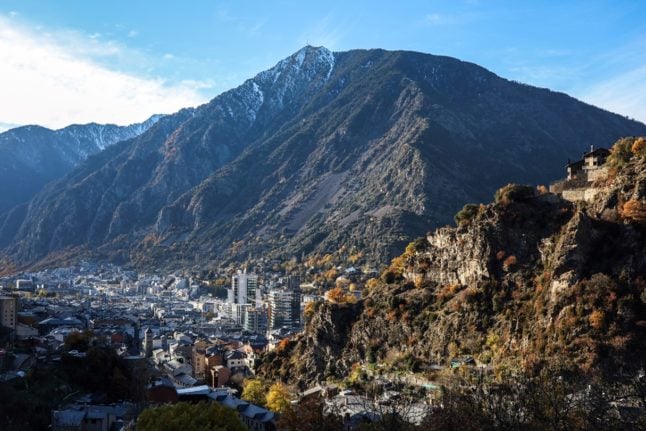She hesitated (considering all sides of the trap) but then said: “My instinct would have been to be with De Gaulle and the Resistance”.
Le Pen rapidly changed the subject. She didn’t want to dwell on the Nazi occupation of France in 1940. Instead, she made a spurious comparison with the alleged 21st century “occupation” of a handful of French streets for Friday Muslim prayers.
All the same, it was telling reply. She had repudiated her father, Jean-Marie, and other founders of the Front National who detested De Gaulle and sympathised with the Nazi-collaborating Vichy regime.
To relaunch and expand the family business, Marine Le Pen realised that she must abandon her father’s implied but never-quite-stated belief that “The Wrong Side” had triumphed in 1945.
Le Pen has since gone much further in de-toxifying the Front National, including changing the party’s name to the Rassemblement National and ditching her papa completely
In France, however, history is buried in shallow graves. World War Two caught up with Marine Le Pen last week.
President Emmanuel Macron had suggested that she should, in all decency, stay away from the state ceremony for the transfer of the remains of a foreign-born, Communist, Resistance leader to the Panthéon, the resting place of France’s official heroes and heroines.
Missak Manouchian, arrested and executed in February 1944, was a one-man affront to the founding genes of the RN, ex-FN. He was a Communist who led a resistance-cell largely composed of Jews. He was an immigrant who gave his life for his adopted country while the ideological ancestors of the ultra-nationalist Le Pen collaborated with the invaders.
READ ALSO Who was Missak Manouchian and why is he important to foreigners in France?
Like the wicked fairy in Sleeping Beauty, Marine Le Pen insisted on going to the Panthéon all the same. She had, she said, the same duty as any other party leader to attend a ceremony for a national hero (even if he was a lefty immigrant).
By a quirk of events, the murder in prison of the Russian opposition leader Alexei Navalny simultaneously confronted Le Pen with another question. On whose side would she be on in World War Three?
Marine Le Pen is a long-standing admirer of Vladimir Putin. Her party was until recently his client for a €6 million loan.
During the 2017 French election, a young Russian artist presented her with a triple portrait of startlingly vulgar post-Soviet kitsch. It showed three blonde, Aryan heroes gazing portentously into the distance – Putin, herself and Donald Trump.
The RN made a great fuss of the painting at the time. Little has been seen of it recently.
Since the second Russian invasion of Ukraine two years ago, Le Pen has distanced herself from Putin. The RN paid off its loan last year (and took out another one with a bank linked to the pro-Putin, Hungarian Prime Minister Viktor Orban).
Like Donald Trump, however, Le Pen remains unwilling to break with the Kremlin completely. There was something sickeningly limp about Marine Le Pen’s statement on the murder of Navalny last week.
“I learn of the death of Alexei Navalny, a political activist engaged in the defence of democracy,” she wrote. “My condolences to his loved ones and his political family.”
No outrage. No mention that he died in a punishment camp in Siberia. He might have been an obscure old man who had died at home.
Contrast the statement by her young party president and de facto Number Two, Jordan Bardella.
“Alexei Navalny died in an Arctic prison where he was serving 19 year sentence for opposing the regime. This is tragic news for all defenders of human rights and fundamental liberties”.
That statement also stinks of hypocrisy. RN members in the European Parliament, including Bardella, have consistently failed to support motions condemning Navalny’s persecution. The Rassemblement National is keen to dismantle human rights in France and the EU.
But at least Bardella was prepared temporarily to put aside the latent Putinolatory of much of French far and hard-right and speak of an act of authoritarian wickedness.
At the time of the first anniversary of the Russian invasion last year, Bardella had already tried to toughen the party’s weaselly words on Putin’s responsibility. He was slapped down by Le Pen.
Despite his vacant boy band good looks, he is a clever young man. He no doubt sees Marine’s reluctance to break completely with the Kremlin in the same way that she once saw her father’s refusal to repudiate Vichy – an irritating PR obstacle in the march to power.
France and Europe may not face World War Three in the near future but we do face a long and painful struggle to continue support for Ukraine. The quislings and the Vichy-sympathisers are already amongst us. Not all the pro-Putin readers’ comments in Le Figaro come from Russian troll factories.
On whose side will Le Pen and Bardella be when difficult choices are needed in the months ahead?
In World War Two those who had brayed most about love of patrie and the ‘foreign menace’ proved to be those most willing to collaborate with and exploit foreign occupation.
Le Pen has stolen a march on them. She has shown herself willing to collaborate with Putinism in advance.



 Please whitelist us to continue reading.
Please whitelist us to continue reading.
Marcel Déat, who collaborated with Hitler to the end along with other collaborators such as Doriot, de Brinon and Darnand, led a fascist party in the 1930s before becoming part of the Vichy machine.
His party was called the ‘Rassemblement national populaire’. Now there’s a coincidence!!
Thank you for this informative article. More please on the personalities and parties as the elections approach. I want to know who would get my vote, were I to have one!